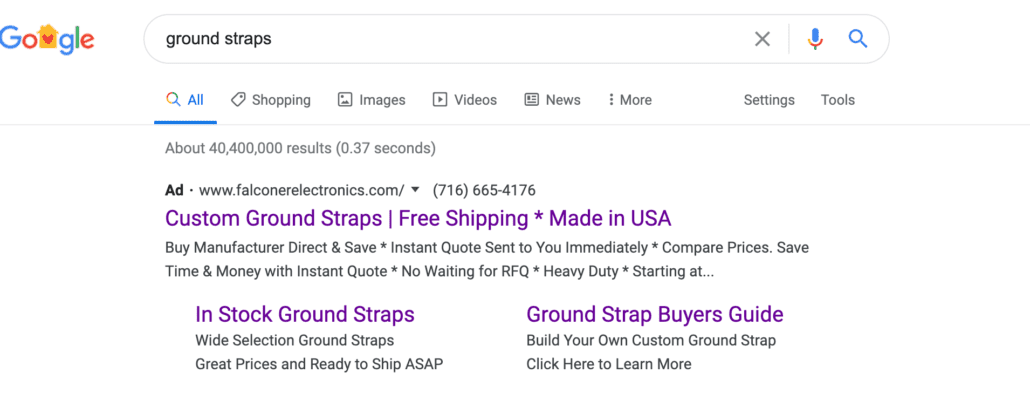Wouldn’t it be great if your company could Dominate Search?
Wait, Dominate Search? Seriously?
Yet, isn’t that the dream of every small business owner and search marketer?
Just think if each and every time an ideal customer or your “soulmate” is searching for the products or services that you provide, there you are, hanging out at the top of search results.
Front and center on Google just waiting to be clicked.
Especially with a customer who is eager and ready to place an order.
It could be a top organic ranking on Google, as well as an image, a video or a paid ad.
Ahh……If only dreams could come true.
If it was 2005 this might be a realistic goal. Yet, today the competition is fierce.
You are competing with gazillions of other web pages for top rankings (btw – is gazillions an actual number?).
How important is an aggressive online marketing strategy?
If I told you there was a trade show going on next door to you with hundreds of buyers looking for your product and processes, what would you do?
You would bust down doors to get in that room. Handing out business cards, company literature, and product information to as many people as possible. Like speed dating. Fast and furious.
Well, that is exactly what the internet offers.
One giant trade show of potential customers searching for vendors.
Looking to buy a product with money burning a hole in their pocket to make purchases.
But you are nowhere to be found.
However, there is hope.
It’s time to start your quest to Dominate Search.
Let’s explore.
Related Article: Seeking Soulmates: Does Your Website Attract Dream Customers?
Not Found in Search = Not in the Game

If you cannot be found on a search, you are simply not in the game.
What does it take to achieve top rankings?
Since 1995, I have worked tirelessly to figure out how to capture traffic and more importantly buyers by gaining top rankings on search engines.
I can attest first hand, it is not easy. Or cheap.
“Getting eyeballs” to a website was the buzz phrase in the 1990s. Eyeballs as well as credit cards to close the sale.
This was especially difficult during the pre-Google days.
Once Google arrived, millions of small business owners made a ton of money with eCommerce.
Google solved a massive problem with bridging the gap by playing matchmaker for a buyer and a seller.
Today, the same holds true.
You must be found when a buyer or potential customer conducts a search for your products. Somewhere.
However, many options exist beyond just Google such as social media sites, videos as well as online marketplaces.
Let’s dig right in.
Related Article: 3 Step Approach To Scaling eCommerce for Manufacturers
3 Pronged Attack with Manufacturing eCommerce Strategies

First, you need a plan.
Even though plans rarely go…..as planned, we still need a direction.
With Manufacturing eCommerce Strategies, let’s continue discussions on our 3 pronged approach:
- Dominate Search
- Make a Great First Webpression
- Get Offensive
This post we are going to primarily discuss how to Dominate Search.
Dominate Search?
Is that even realistic?
It depends.
What is not realistic?
Well, one example would be if you insist on earning #1 organic Google ranking for the keyword “Shoes”.
Unless you own Nike or have an equivalent marketing budget, we most likely need a different strategy.
When clients say they want a #1 organic ranking of highly competitive or popular terms, my response goes as follows: “you have a better chance of seeing me with hair”. In other words, that’s simply never going to happen.
However, don’t be discouraged. We simply need to focus on alternative routes.
Plenty of fun and creative strategies to achieve your goals lie ahead waiting for you.
In many cases, there are plenty of tremendous opportunities to capture top search rankings, especially for manufacturer’s niche keywords.
Related Article: You Have Only One Chance to Make an Outstanding First Webpression
Search Your Keywords
For starters, what are your keywords?
If this new to you, keywords are the products and services that you are absolutely best at.
In other words, your products, proprietary processes, and core capabilities all represent your keywords.
Let’s do an exercise.
When you Google your keywords, does your company appear in the search results?
Do you show up at the top of the 1st page on Google?
Otherwise, do you show up at all anywhere on the first page?
If not, this is a major concern.
Are you ok with this or does this make you angry?
Even worse, did you notice the names of the other companies that do show up?
For example, any competitors on the first page?
Companies that you are well aware of but had no idea that they were tech savvy and Google friendly.
Next, let’s click on the sites that do show up. Especially since they are your competition.
How do those sites look?
Comparing yourself to these websites, how do you stand?
Are you in decent shape? Holding your own? Does your website look better than the competition?
If the answer is no, are you frustrated? Feel behind the curve?
Deeply concerned? Even mad? Good!
Related Article: Top 13 Reasons Why Manufacturers Struggle with eCommerce
Hopefully, You Are Mad

Anger is an excellent source of motivation.
If you are indeed mad, it’s now time to get in the game.
Get on the field as soon as possible. Throw a block. Make a tackle. Get dirty.
It is definitely not too late. Now is the time to take action.
A vast majority of my clients are digital immigrants. What is a digital immigrant?
Well, if you just asked yourself that question, you are probably a digital immigrant. Digital immigrants are those of us born before 1980.
Many digital immigrants in manufacturing claim they have spent years “flying under the radar” and “being the best-kept secret”.
Sound familiar?
Gaining customers and building your business through word of mouth.
Well, now the time has come where you need to stop being the “best-kept secret”.
Many manufacturers are experts in their field who say if they can just get a client on the phone or engaged, they know they can close the sale.
Well, the challenge now, how does a company that has intentionally ignored technology and search engine strategies get into the game quickly, affordably as well as painlessly?
Dominating Search is Marketing 101
If you are not capitalizing on search, what are you doing? How can a potential customer find you?
Especially if a buyer is a digital native.
Think about this, Facebook was founded in 2003. College students who were early adopters to social media at that time are now well into their 30s with some reaching 40 years of age.
These individuals are business owners, professionals, purchasing agents, buyers as well as in management positions.
They are entering positions of power and authority.
Where is the first place they go to make a buying decision?
They are researching Google, social media sites as well as online marketplaces.
If you are nowhere to be found, you are in trouble. They are not going to page 5,6, or 7 of Google hoping to find you.
What do we do?
Let’s roll up our sleeves and get you in the game.
Don’t be overwhelmed. We are not “eating the elephant”.
You may feel years behind. Yes, it would be nice starting the “Dominate Search” party like its 2003.
But it is not 2003. No need to dwell on the past. You are here now and ready to take your business in a new direction.
This is a long term plan. A lifestyle change. We are creating new habits.
We are running a marathon not a sprint.
The finish line is way out in the distance. The push forward.
“The best time to plant a tree was 20 years ago. The second best time is now.”
Starting Points to Help Manufacturers Dominate Search
Below includes several starting points on our quest to Dominate Search that we will discuss throughout this post:
- Establish a List of 10-20 Critical Keywords: Your core products and capabilities (be specific)
- Blogging
- Post Videos (educational, how-to, informational, explain processes, describe machinery)
- Consistently post on social media sites (LinkedIn, Facebook, Instagram, Twitter, YouTube)
- Set Up Google Business Profile
- Google Ads
- Business Directories: List your business on all relevant business directories
- Place products on online marketplaces (Ex: Amazon, Walmart, Zoro)
Related Article: Like It or Not, Your Website is Your 24/7 Sales Rep
Share Your Vision to Dominate Search With Your Web Designer

First, let’s create a team and circle the wagons.
Surround yourself with experts to help you achieve a successful strategy.
Just the same as your customers come to you because of your expertise.
Your efficiency. High quality products. Timeliness.
Above all, customers trust you. Otherwise, you would not already be this successful. Right?
Of course, let’s not forget about your likability and the fact that you are pretty darn cute as well.
Hopefully, you feel the same about your web designer (maybe not the cute part).
As a business owner, it is critical to surround yourself with professionals who have your back.
It is said it takes a village to raise a child, well it also takes a village to raise a business.
As a small business owner, you throw on many hats. That’s just in the first hour of the day.
For example, you need an outstanding accountant, a reliable payroll service, a trustworthy insurance agent as well as a rock-solid attorney.
Well, you need all of these qualities in your web designer as well.
In order to take steps towards our Dominate Search strategy, you need support.
This post is not a guide on how to do everything on your own. Which is certainly great if you have the time, energy and stamina to do so.
I strongly encourage you to partner with individuals who see your vision and are eager to jump on your “Dominate Search” train.
Dominate Search Starters
Therefore, this list includes several absolute top priorities to discuss with your web designer:
- Purchase SSL Certificate: a digital certificate that provides authentication for a website as well as enables an encrypted connection.
- Set up Google Analytics
- Make website speed a top priority
- Responsive and mobile-friendly website (critical)
- Set up an eCommerce store
- Add products and services to your site
- Add content (and lots of it)
- Did I mention videos? (and lots of them)
Creating Content
Are you sick and tired of everyone telling you to “create content”?
Does your web designer keep suggesting that you start blogging?
By the way, who on earth has time for blogging?
Especially if you are in manufacturing. You make stuff. You are a widget expert.
If you wanted to “create content” or blog you would have gone to journalism school, right?
Does the thought of “blogging” and actually typing out an article to make your skin crawl?
Who has time to sit down and type out a 600-900 word blog?
You have orders to fill and fires to put out.
Even if there was time to blog, who is going to actually read the blog.
More importantly, how would they even find it.
Well, let’s start small.
Think of a topic about your business that you could recite in your sleep.
Is there a product, process, item that you just can not stop talking about?
Blogging Helps You Dominate Search
I recall sitting with a client and their team. They said “there is nothing really to discuss. What would we actually blog about?”
Since then, they eventually created hundreds of blog posts and now posses dozens of First Page Google Rankings on their keywords.
All thanks due to a change in attitude while also building an aggressive approach to blogging. In a year’s time, they increased website traffic by over 1000%.
Attracted a tremendous amount of new customers as well as substantially increased online sales.
More importantly, the company discovered newfound energy and excitement with this exciting new direction.
Below shows the search results for one of their core products, Electrical Ground Straps.
As you can see, they possess the coveted Google Featured Snippet position.
Featured snippets are special boxes where Google pulls information directly from a website showing the descriptive snippet first. In addition, this is a FREE position costing the winner of the snippet spot absolutely nothing.
Gaining the Google Featured Snippet position is certainly challenging and comes with no guarantees to maintain that position.
However, it is a nice victory for your company to earn this top spot.

Create a Blog Series
Think of topics that would evolve into a series. Make it educational as well as fun for your customers.
A few suggestions include:
- Break out a case study into sections – client first contacted you – how you bid the job – won the job – improved quality – saving them time and money
- Do a series on you entering eCommerce – people love to root for the underdog
- Why “Made in the USA” is best
- Why Onshoring is better than offshoring
- Benefits of outsourcing to a custom manufacturer
- Machinery or equipment reviews
- Tariff impact on your industry
- Steps or Advice on how to outsource
- Latest industry trends
- Case study on how you saved a client time and money
- Questions to ask during the quoting process
- Meet the Team
- How (and why) you started your company
Still stuck? Hate to type.
Grab your cellphone. Click on the video. Hit play and just start talking about your business. Your products. The process that separates you from the competition.
You don’t need to be salesy.
Be educational. Explain your proprietary process. Teach the listener something new that you gained over your journey of perfecting your process.
Related Article: 25 Blog Topics for Manufacturers Eager to Start Blogging
List of Blogging Benefits for Manufacturers
Blogging benefits for manufacturers include:
- Take Your Website Beyond a Business Card
- SEO Value
- Build Brand Authority
- Demonstrate Your Expertise
- Use blogs as Social Media Post
- Turn short content into long
- Turn long content into short
- Link Building
- Increase leads
- Educate your customers and prospects
- Share Your Passion
- Be Your Charming Self
- Start a newsletter
- Promote offers
- Show off your team – machinery – equipment
- Announce new products – machinery – equipment –
- Highlight staff & their expertise
- Create Checklists and other helpful purchasing information to assist with buying decision
- Address common questions with FAQ
E-A-T

Additional thoughts to consider on your quest to Dominate Search include the letters E-A-T.
When you hear the letters “E-A-T”, you naturally think of food.
Typically a favorite time of day. Breakfast, lunch or dinner. Something nutritious to provide you with needed energy.
Hopefully something scrumptious and delicious.
Well, Google has another interpretation for “E-A-T” that also satisfies hunger.
In this case, Google helps cure your hunger for new customers.
“E-A-T” nows plays a critical role with your company obtaining top rankings on Google.
What does E-A-T stand for according to Google?
E = Expertise
A = Authority
T = Trustworthiness
Google certainly has evolved over the years and continues to do so.
Search results today rely heavily on expertise, authority, and trust
Just as you strive to deliver an excellent customer experience, Google owns the same mission.
Google works relentlessly to provide valid and accurate information in search results.
Google is determined to provide a high level experience as well as high quality search results with trustworthy content.
In other words, no fake news.
Check out this helpful article from Path Interactive’s Lily Ray on “What Does It Mean to Have Good E-A-T?”
Lily Ray explains E-A-T as follows:
Google’s algorithms identify signals about pages that correlate with trustworthiness and authoritativeness. The best known of these signals is PageRank, which uses links on the web to understand authoritativeness. ~ What Webmasters Should Know About Google’s Core Updates, 2019
E-A-T More
Focus on creating content that helps the buyer make a buying a decision while building your online authority.
- Educational articles
- How-to videos
- Instructional information
- White papers
- Case studies
- Create Resource Guides
Connecting buyers with these resources help to build your credibility.
The bottom line, be the widget expert and consistently display your authority while building trust with your online strategy.
This is truly nothing new and an age-old strategy.
What has changed now is striving to communicate this message with your online presence.
As mentioned previously with earning the Google Featured position, committing to the E-A-T strategy pays healthy dividends.
Especially when Google views your company as a trustworthy resource for your core capabilities, proprietary processes, and products.
Dominate Search with Your BFF Google

Google offers an arsenal of powerful tools and resources to help you achieve your goals.
It is virtually impossible to Dominate Search without a deeply dedicated Google strategy.
Below includes several Google family members that each play a critical role in your quest to Dominate Search.
Google Ads
Looking for quick results to get in the game immediately requires a few dollars of inventment.
Google also offers a pay-per-click model where you pay to play called Google Ads.
As an eCommerce dinosaur, I started using paid search ads in the year 2000.
Previous to Google Dominating Search, Yahoo was the top player in search when they purchased Overture in 2003.
Sadly for Yahoo, they completely dropped the ball allowing Google to become…..well…….Google.
The rest is history.
A Google pay-per-click ad works exactly as described. It does not cost a penny to obtain a paid ad position such as #1. It only costs you money once a user clicks your ad.
In addition, if your keywords are popular, the bidding price per click can be quite expensive. Therefore, Google ads add up quickly so watch your budget closely.
Below shows the search results for Google Ads. Whenever you see a Google search result, take note of the word “Ad”. That means someone is bidding for that location.
Click here to explore Google Ads

Google Shopping
Just like Google Ads, Google Shopping works as a pay-per-click auction model. You never pay to show up in a search. However, you pay each time a user clicks your ad.
The difference, Google shopping displays an image of your product as opposed to just a text ad.
Google Shopping offers a powerful solution by allowing the buyer to see a product along with a price.
The image helps prevent unwanted clicks as well as offer the opportunity for higher conversions.
Google Shopping is a new product discovery experience. The goal is to make it easy for users to research purchases, find information about different products, their features and prices, and then connect with merchants to make their purchase.
Below shows an example of Google Shopping search results.
To learn more about Google Shopping, click here

Google Business Profile
Google offers Google My Business as a means for your company to appear in local search results. This including showing up on Google Maps. Google Business Profile allows you to engage with customers on Google for free.
With a Google My Business account, you get more than a business listing. Your free Business Profile lets you easily connect with customers across Google Search and Maps.
To learn more about Google Business Profile – click here
Google Analytics
Google Analytics gives you the free tools you need to analyze data for your business in one place. If you love data, you will love Google Analytics.
Check out this guide on Google Analytics from SEMrush: The Beginner’s Definitive Guide to Google Analytics
Google Analytics offers key information such as:
- Number of unique visitors to your website
- Which pages are the most popular on your website
- Website speed
- Referring websites (where is traffic coming from)
- Mobile vs PC visitors
- and much more…
Click here to learn more about Google Analytics
Google Search Console
Another valuable tool for you includes Google Search Console which helps you measure your site’s Search traffic and performance, fix issues, and make your site shine in Google Search results.
The tools and reports on Google Search Console play a vital role in improving website traffic and user experience. For example, Google Search Console allows you to track other websites linking to yours, index each landing page and also inspect each page as well.
Click here to learn more about Google Search Console
NJG = Not Just Google
Let’s not ignore alternatives on your quest to Dominate Search.
Google certainly plays a critical role when a potential buyer conducts an online search.
However, plenty of other options exist to expand your reach.
- Social Media: Facebook, Instagram, LinkedIn, Pinterest, Tik Tok, Twitter, YouTube
- Industrial Trade Mags: Examples include Modern Machine Shop, Assembly, Engineering 360
- Medium: A free publishing platform. Post all articles and content on Medium
- Reddit: Join relevant groups on Reddit. Post all articles and join discussions. However, do NOT be salesy on Reddit.
- Online Marketplaces: such as Amazon, Digi-Key, eBay, McMaster-Carr, Walmart and Zoro (We will dig deeper into pursuing online marketplaces on step 3: Get Offensive).
Helpful Resources to Help You Dominate Search
As you dig into this process, you will hunger to learn more about how to Dominate Search. Especially once you achieve that first eCommerce sale. Capturing eCommerce sales truly becomes addicting (in a good way).
Below includes a list of helpful resources from experts with years of experience to help you with the process:
Wrapping It Up
Thanks for reading this post.
Hopefully, you found this information helpful.
Please click below for additional helpful articles as you begin your eCommerce journey:



































